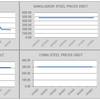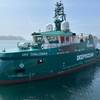In recent weeks, we have examined various aspects of Chinese shipping developments and we make no apology for reporting a recent New York conference at which China was again the key focus. The country is, after all, the principal factor that is fueling the dry and liquid bulk markets and the container trades. Only a few tanker owners can remember super-profits on today’s scale and bulk carrier owners have only ever dreamt of the rates prevailing today.
Shipbuilding capacity in China, meanwhile, is expanding at an exponential rate and, in the long term, it is the shipbuilders’ strategy to be building half of the world’s ships by 2050. They could be doing that long before then, some already believe. The country already has more shipyards than any other nation, although both productivity and profitability remain poor.
At the tenth annual joint conference of the Norwegian-American and Hellenic American Chambers of Commerce held at New York’s Helmsley Hotel earlier this month, a range of diverse speakers addressed the issue: “Powering the Markets: the Chinese Colossus”. The topics covered various sectors – including shipbuilding – and the inevitable question as to when the Chinese bubble might burst was addressed by various speakers.
In a recent report, New York broker Poten & Partners reviewed some of the conference discussions. First – a few statistics. By 2007, China’s middle class is estimated to reach 300 million people, equal to the current U.S. population. China attracted about $50 billion of direct foreign investment last year, mostly for manufacturing. U.S. retailer Walmart alone buys $15 billion worth of goods a year from Chinese suppliers. More than half of China’s exports is by subsidiaries of foreign multinationals. The country’s shipbuilders completed 6 million dwt of ships during 2003, up by 46% on the previous year. Chinese ports handled 48 million teu last year, the largest volume in the world.
On energy, China’s demand for oil is second only to the U.S. The country was a net exporter of oil until about 1993. Today, it imports about 60% of its oil and volumes are rising rapidly. Its present consumption of about 5.26 million b/d is expected to increase by more than 100% by 2025, to almost 11 million b/d. If China’s 1.28 billion people were ever to reach the level of car ownership prevailing today in the U.S. (1.9 vehicles per household), all known oil reserves would soon be depleted.
During 2003, China consumed 21% of the world’s trade in aluminum, 25% of zinc, 29% of iron ore, 19% of copper and 25% of stainless steel. Large number of extra Panamax bulk carriers are needed to carry extra demand for coal and soybeans, one speaker noted. An additional 40 Panamax units are now needed for extra coal imports while another 49 such ships are required for soybeans. Meanwhile new ship orders booked by the country’s builders increased two-and-a-half times during 2003.
According to Poten’s review, Dr Edward Yardeni, chief investment strategist and managing director of Prudential Equity Group in New York, addressed the all-important question of when the Chinese bubble might burst during a luncheon speech. He pointed out that a number of people equivalent to the size of the city of Houston – 20 million – were leaving rural China for the cities every year. More than five million new cell phones are being sold every month. However, Yardeni’s conclusion was that the bubble would not burst until at least 2008. If he is right, the global profile of shipowning and shipbuilding could be completely different by then.
Sponsored Content
Experience Custom Yacht Signs and Designs Tailored to Perfection!

Featured videos

Energy Transition in Maritime is More than the Fuel

FloCloud: Tracking, Documenting Weld Efficiency
April 2025
 Read the Magazine
Read the Magazine

 Read the Magazine
Read the Magazine
This issue sponsored by:

Modernizing Mariner Credentialing: A Maritime Workforce Imperative
Subscribe for
Maritime Reporter E-News
Maritime Reporter E-News is the maritime industry's largest circulation and most authoritative ENews Service, delivered to your Email five times per week







